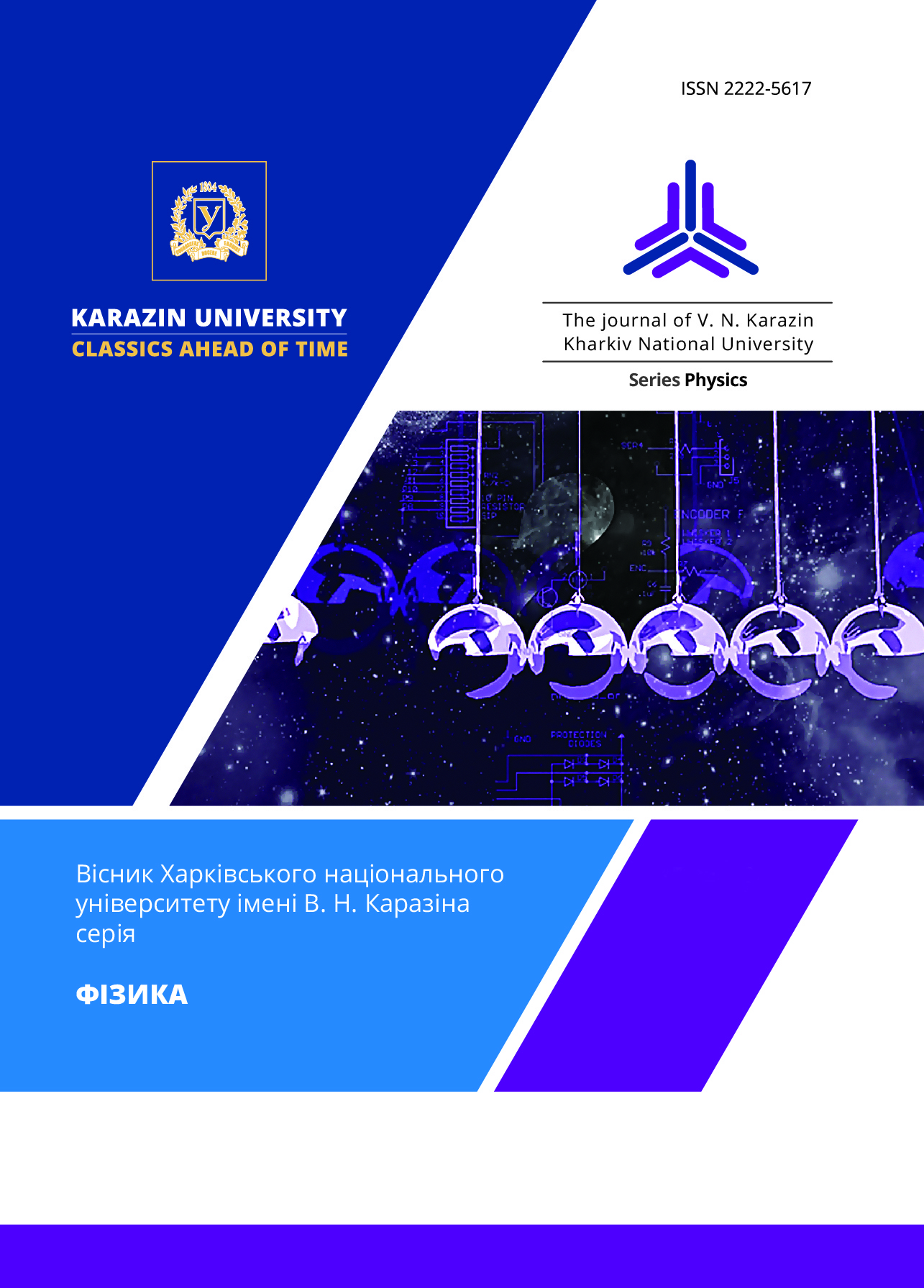PECULARITIES OF HIRST EXPONENT ESTIMATION FOR NATURAL PHYSICAL PROCESSES
Abstract
In bounds of the non-linear and system paradigms, been formulated by L. F. Chernogor in the last 1980th, all processes in open, non-linear, dynamical systems are very complex, non-linear, ultra-wideband or fractal ones.
According to the fractal paradigm put forward in the early 2000s by V. V. Yanovsky, fractality is one of the fundamental properties of the surrounding world. Therefore, the study of fractal characteristics, in particular, of natural physical processes is actual, interesting and useful.
The fractal dimension based on the Hurst exponent is one of the oldest and most famous ones. Based on the study of model fractal signals, it is demonstrated that the dependence between the estimate of the Hurst fractal dimension, obtained by the normalized range method, and its true value is significantly non-linear. To decrease of influence of the errors arising as a result of this, it is proposed to use the method of the corrective function.
The practical effectiveness of the proposed method is demonstrated on the example of the analysis of experimental results obtained in the middle 1960s by H. E. Hurst, which discovered the presence of a somewhat strange grouping of the values of the Hurst fractal dimension around the value of 1.27 for various natural physical processes. A hypothesis about the possibility of explaining this fact precisely by the nonlinearity of the mentioned dependence for R/S-method was proposed.
Downloads
References
B. B. Mandelbrot. The Fractal Geometry of Nature, San Francisco, CA-Freeman (1982), 460 p. https://doi.org/10.1119/1.13295
K. J. Falconer. Fractal Geometry. Mathematical Foundations and Applications, Chichester, Wiley & Sons (1990), 288 p. https://doi.org/10.1002/0470013850
J. Feder. Fractals, New York, Plenum Press (1988), 305 p. https://link.springer.com/book/10.1007/978-1-4899-2124-6
E. Chandrasekhar, V. P. Dimri, V. M. Gadre, editors. Wavelets and Fractals in Earth System Sciences, CRC Press (2014), 294 p. https://doi.org/10.1201/b16046
D. P. Feldman. Chaos and Fractals. An Elementary Introduction, Oxford, University Press (2012), 408 p. https://doi.org/10.1093/acprof:oso/9780199566433.001.0001
B. B. Mandelbrot. Fractals and Chaos: The Mandelbrot Set and Beyond, Springer (2005), 400 p. https://doi.org/10.1186/1475-925X-4-30
R. M. Crownover. Introduction to Fractals and Chaos, Boston, Jones and Barlett Publishers (1995), 320 p. https://www.amazon.com/Introduction-Fractals-Chaos-Bartlett-Mathematics/dp/0867204648
B. B. Mandelbrot. Multifractals and 1/f Noise, Springer (1999), 442 p. https://doi.org/10.1007/978-1-4612-2150-0
D. Harte. Multifractals. Theory and Applications, Boca Raton, Chapman and Hall/CRC Press (2001), 264 p. https://doi.org/10.1201/9781420036008
M. Schroeder. Fractals, Chaos, Power Laws. Minutes from Infinite Paradise, New York, W. H. Freeman and Company (1991), 528 p. https://www.amazon.com/Fractals-Chaos-Power-Laws-Infinite/dp/0486472043
F. C. Moon. Chaotic Vibrations. An Introduction for Applied Scientists and Engineers, New York, Wiley and Sons (2004), 309 p. https://doi.org/10.1002/3527602844
O. V. Lazorenko, L. F. Chernogor. Radio Phys. Radio Astron., 25 (1), 3 (2020) (in Russian). https://doi.org/10.15407/rpra25.01.003
V. V. Yanovsky. Universitates, 3, 32 (2003) (In Russian).
V. V. Yanovsky. Lectures on Nonlinear Phenomena. Volume 1, Kharkiv, Institut monokristallov Publ. (2006), 456 p. (in Russian).
L. F. Chernogor. On the Nonlinearity in Nature and Science, Kharkiv, V. N. Karazin Kharkiv National University (2008), 528 p. (In Russian).
O. V. Lazorenko, L. F. Chernogor. Radio Phys. Radio Astron., 28(1), 5 (2023) (in Ukrainian). https://doi.org/10.15407/rpra28.01.005
H. E. Hurst. Trans. Amer. Soc. Civ. Eng., 116, 770 (1951).
H. E. Hurst, R. P. Black, Y. M. Simaika. Long-term storage: an experimental study, London, Constable (1965), 145 p.
L. F. Chernogor, O. V. Lazorenko, A. A. Onishchenko. Low Temperature Physics, 49(4), 459 (2023). https://doi.org/10.1063/10.0017581
H. H. Hardy, R. A. Beier. Fractals in Reservoir Engineering. Singapore, New Jersey, London, Hong Kong, World Scientific (1994), 359 p. https://doi.org/10.1142/2574
L. Seuront. Fractals and Multifractals in Ecology and Aquatic Science, Boca Raton, London, New York, CRC Press (2010), 344 p. https://doi.org/10.1201/9781420004243
B. Mandelbrot, J. R. Wallis. Water Resources Res., 5(1) 228 (1969). https://doi.org/10.1029/WR005I001P00228
J. B. Bassingthwaighte. News Physiol. Sci., 3, 5 (1988). https://doi.org/10.1152/physiologyonline.1988.3.1.5
N. Scafetta, P. Grigolini. Phys. Rev. E, 66(3), 036130 (2002). https://doi.org/10.1103/physreve.66.036130
J. H. Van Beek, S. A. Roger, J. B. Bassingthwaighte. Am. J. Physiol., 257(5), H1670 (1989). https://doi.org/10.1152/ajpheart.1989.257.5.h1670
H. M. Hastings, G. Sugihara. Fractals: A User’s Guide for the Natural Science, Oxford, Oxford University Press (1993), 248 p. https://www.amazon.com/Fractals-Natural-Sciences-Science-Publications/dp/0198545975
R. F. Peltier, J. Lévy-Véhel. Research report, INRIA Rocqencourt (1994). https://hal.inria.fr/inria-00074279
J. Beran. Statistics for Long-Memory Processes, Chapman and Hall (1994), 328 p. https://doi.org/10.2307/2983481
C.-K. Peng, S. V. Buldyrev, S. Havlin, M. Simons, H. E. Stanley, A. L. Goldberger. Phys. Rev. E., 49, 1685 (1994). https://doi.org/10.1103/PhysRevE.49.1685
M. S. Taqqu, V. Teverovsky, W. Willinger. Fractals, 03(04), 785 (1995). https://doi.org/10.1142/s0218348x95000692
M. J. Cannon, D. B. Percival, D. C. Caccia, G. M. Raymond, J. B. Bassingthwaighte. Physica A: Statistical Mechanics and Its Applications, 241(3-4), 606 (1997). https://doi.org/10.1016/s0378-4371(97)00252-5
N. Vandewalle, M. Ausloos. Phys. Rev. E, 58(5), 6832 (1998). https://doi.org/10.1103/physreve.58.6832
A. Eke, P. Hermán, J. Bassingthwaighte, G. Raymond, D. Percival, M. Cannon, … C. Ikrényi. Pflügers Archiv - European Journal of Physiology, 439(4), 403 (2000). https://doi.org/10.1007/s004249900135
S. M. Prigarin, K. Hahn, G. Winkler. Numerical Analysis and Applications, 2(4), 352 (2009). https://doi.org/10.1134/s1995423909040077
M. A. Riley, S. Bonnette, N. Kuznetsov, S. Wallot, J. Gao. Frontiers in Physiology, 3 (2012). https://doi.org/10.3389/fphys.2012.00371
M. J. Sánchez-Granero, M. Fernández-Martínez, J. Trinidad-Segovia. The European Physical Journal B, 85(3), 86 (2012). https://doi.org/10.1140/epjb/e2012-20803-2
T. Gneiting, H. Sevcikova and D. B. Percival. Statist. Sci., 27, 247 (2012). https://doi.org/10.1214/11-STS370
M. S. Taqqu. Stochastic Processes and Their Applications, 7(1), 55 (1978). https://doi.org/10.1016/0304-4149(78)90037-6
H. E. Hurst, R. P. Black, Y. M. Simaika. Long-term storage: an experimental study, London, Constable (1965), 145 p. https://doi.org/10.2307/2982267
O. V. Lazorenko, A. A. Onishchenko, L. F. Chernogor. Radiotekhnika: All-Ukr. Sci. Inter- dep. Mag., 210. 177 (2022). (in Ukrainian). https://doi.org/10.30837/rt.2022.3.210.15.
C. Bandt, M. Barnsley, R. Devaney, K. J. Falconer, V. Kannan, P. B. Vinod Kumar, editors. Fractals, Wavelets, and their Applications: Contributions from the Int. Conference and Workshop on Fractals and Wavelets (Springer Proceedings in Mathematics & Statistics), Switzerland, Springer Int. Publ. (2014), 508 p. https://www.amazon.com/Fractals-Wavelets-their-Applications-Contributions-ebook/dp/B00PUM0AQ2








3.gif)
